Summary
A New Variorum is a research edition of a Shakespeare play, meant to be authoritative and encyclopedic, providing an extensive commentary and a relatively complete history of the transmission and editing of the text. At the same time, “the main purpose of the text of a Variorum Edition should be to accommodate the commentary and collations as efficiently, i.e., as economically and conveniently, as possible” (NVS Handbook, ed. Richard Knowles, 2003, p.6). Our website is intended to introduce the basics of our project to those who are unfamiliar with textual editing. Our menu to the left provides a sample page with links to the various components of our edition, an account of the performance history of Julius Caesar, tools for those who are interested in perusing earlier editions of the play, especially the work of our predecessor, H. H. Furness, Jr., and a tribute to the founder of our project. 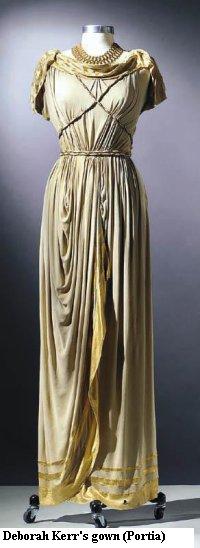 Cinematic productions are essential to our conception of the edition, also, such as the1953 Joseph L. Mankiewicz film production.
Cinematic productions are essential to our conception of the edition, also, such as the1953 Joseph L. Mankiewicz film production.
Chicago Shakespeare Theater production of Julius Caesar at Navy Pier, 5 February-24 March 2013
Watch this space for details, or go to the CST website.
Toneelgroep Amsterdam: Romeinse Tragedies (dir. Ivo van Hove)
This recent production at the Barbican Theatre from 20-22 November 2009 was a conflation and reimagining of three of Shakespeare’s Roman plays, Coriolanus, Julius Caesar and Antony and Cleopatra. 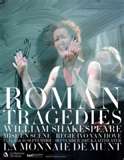 The original description explains that it “is edited and performed consecutively in a lucid and dramatic multimedia spectacular, which engages the senses in a performance that will keep you talking well after you leave the theatre. Urgently exploring issues of power, personal ambition and national interest, this epic performance is augmented through the use of film and live television screens
The original description explains that it “is edited and performed consecutively in a lucid and dramatic multimedia spectacular, which engages the senses in a performance that will keep you talking well after you leave the theatre. Urgently exploring issues of power, personal ambition and national interest, this epic performance is augmented through the use of film and live television screens  which can be viewed from all angles. Roman Tragedies is a gripping 6-hour spectacle in which the audience is invited to view the action close up, moving between the auditorium and the stage.” Read Sarah K. Scott’s essay about the production, as well as other reviews (Independent; Guardian). Watch the trailer. See more images from this production here.
which can be viewed from all angles. Roman Tragedies is a gripping 6-hour spectacle in which the audience is invited to view the action close up, moving between the auditorium and the stage.” Read Sarah K. Scott’s essay about the production, as well as other reviews (Independent; Guardian). Watch the trailer. See more images from this production here.
1691 Quarto for Sale
Baumann’s Rare Books in New York has a copy of Q1691, available for purchase, for the sum of $40, 000. It appears to be a handsome and clean copy: “Four undated quarto editions were formerly thought to have been printed shortly after 1684 and before this 1691 edition; it is now believed that they were probably printed between 1695 and 1700. The first and second 1691 quarto editions have ‘1691’ printed on the title page. This, the earlier of those two editions, has a comma after ‘Herringman’ in the title page imprint statement, while the later 1691 edition does not. Wing S2922. Jaggard, 319. Bartlett 117. Spot of sticker residue to front endpaper. 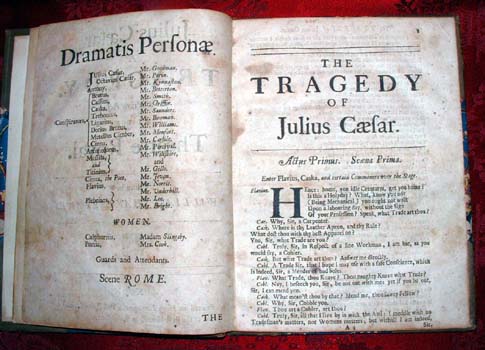 Early ink bracket and ink stain. A few short closed marginal tears to title page. Tiny hole to B2 affecting two words, upper margin slightly worn affecting just a few page numbers, mild embrowning to text. An exceptional and most desirable copy. Rare.” The standard bibliographical account of the seventeenth-century Julius Caesar quartos is John W. Velz, “‘Pirate Hills’ and the Quartos of Julius Caesar,” Publications of the Bibliographical Society of America 63 (1969): 177-93. Both Q1691 and Q1694 feature a cast list that complements the dramatis personae, which includes Ned Kynnaston as Antony and Thomas Betterton as Brutus.
Early ink bracket and ink stain. A few short closed marginal tears to title page. Tiny hole to B2 affecting two words, upper margin slightly worn affecting just a few page numbers, mild embrowning to text. An exceptional and most desirable copy. Rare.” The standard bibliographical account of the seventeenth-century Julius Caesar quartos is John W. Velz, “‘Pirate Hills’ and the Quartos of Julius Caesar,” Publications of the Bibliographical Society of America 63 (1969): 177-93. Both Q1691 and Q1694 feature a cast list that complements the dramatis personae, which includes Ned Kynnaston as Antony and Thomas Betterton as Brutus.
New bust of Julius Caesar?
A French team led by the irrepressible Luc Long claims to have uncovered the only bust of Caesar  created in his lifetime, circa 46 BCE, two years before his death. There is some controversy about its
created in his lifetime, circa 46 BCE, two years before his death. There is some controversy about its 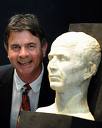 authenticity, but everyone agrees that it is an exciting event in archaeology, classical studies, and art history. The piece, dredged up from the Rhône, is housed in the Musée Départmental de l’Arles Antique. Read the article in The New York Times. Explore the essay in National Geographic devoted to the find. We offer pictures of Long emerging from the deep with the bust and then with the restored artifact, sans scuba.
authenticity, but everyone agrees that it is an exciting event in archaeology, classical studies, and art history. The piece, dredged up from the Rhône, is housed in the Musée Départmental de l’Arles Antique. Read the article in The New York Times. Explore the essay in National Geographic devoted to the find. We offer pictures of Long emerging from the deep with the bust and then with the restored artifact, sans scuba.
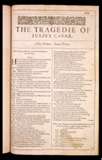 The New Variorum Shakespeare Julius Caesar: A Work in Progress
The New Variorum Shakespeare Julius Caesar: A Work in Progress